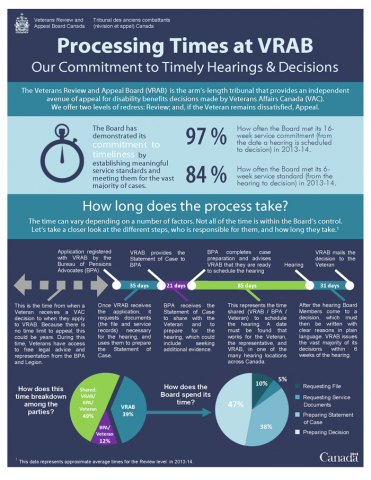Timely Service - 2014
The Board's mission is to provide timely, respectful hearings and fair, plain-language decisions to Veterans, Canadian Armed Forces and RCMP members, and their families who turn to the Board for redress of their disability benefits decisions.
When a Veteran applies to the Board, not all of the time between application and decision is within the Board's control. But, for the parts of the process that are within our control, we have established meaningful service standards that we meet for the vast majority of cases. Please consult this infographic in PDF form, or below to learn about our process and how long it takes.
Text Version
Processing Times at VRAB - Our Commitment to Timely Hearings & Decisions
The Veterans Review and Appeal Board (VRAB) is the arm's-length tribunal that provides an independent avenue of appeal for disability benefits decisions made by Veterans Affairs Canada (VAC). We offer two levels of redress: Review; and, if the Veteran remains dissatisfied, Appeal.
The Board has demonstrated its commitment to timeliness by establishing meaningful service standards and meeting them for the vast majority of cases.
In 2013-14, the Board met its 16-week service commitment (from the date a hearing is scheduled to decision) in 97% of cases, and its 6-week service standard (from the hearing to decision) in 84% of cases.
How long does the process take? The time can vary depending on a number of factors. Not all of the time is within the Board's control. Let's take a closer look at the different steps, who is responsible for them, and how long they take. (The data presented below represents approximate average times for the Review level in 2013-14).
The infographic shows a horizontal timeline for the disability benefits adjudication process. The following describes the process from the start of the timeline to the end:
- This is the time from when a Veteran receives a VAC decision to when they apply to VRAB. Because there is no time limit to appeal, this could be years. During this time, Veterans have access to free legal advice and representation from the BPA and Legion.
- Application registered with VRAB by the Bureau of Pensions Advocates (BPA).
- Once VRAB receives the application, it requests documents (the file and service records) necessary for the hearing, and uses them to prepare the Statement of Case. This step takes 35 days.
- VRAB provides the Statement of Case to BPA.
- BPA receives the Statement of Case to share with the Veteran and to prepare for the hearing, which could include seeking additional evidence. This step takes 21 days.
- BPA completes case preparation and advises VRAB that they are ready to schedule the hearing.
- This represents the time shared (VRAB/BPA/Veteran) to schedule the hearing. A date must be found that works for the Veteran, the representative, and VRAB, in one of the many hearing locations across Canada. This step takes 85 days.
- Hearing.
- After the hearing Board Members come to a decision, which must then be written with clear reasons in plain language. VRAB issues the vast majority of its decisions within 6 weeks of the hearing. This step takes 31 days.
- VRAB mails the decision to the Veteran.
The infographic then shows two pie charts. The first answers the question “How does this time breakdown among the parties?” with the following percentages:
- 49% is shared between VRAB/BPA/Veteran
- 39% belongs to VRAB
- 12% belongs to BPA/Veteran
The second pie chart answers the question “How does the Board spend its time?” with the following percentages:
- 10% requesting the file
- 5% requesting the service documents
- 38% preparing the Statement of Case
- 47% preparing the decision
- Date modified:
